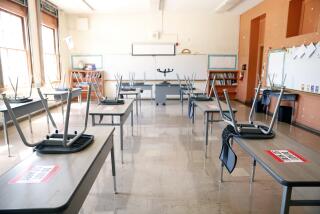Talk It Out, Don’t Duke It, Mediation Teaches Students
- Share via
Sean says Steve shoved him in the hallway. Donna says Sheila swore at her. Susan says Jose took her pencil. Bruce says Bill took his girlfriend.
But instead of duking it out, students at Santa Monica’s John Adams Middle School can mediate.
The program, organized by Santa Monica-based Dispute Resolution Services, unites quarreling students with peer mediators who help them settle disagreements. It aims to reduce fights and give students a cooperative outlook and a sense of responsibility, officials say.
“Conflict is a natural result of living,” said Judy Goldman, director of Dispute Resolution Services’ mediation program for schools, which includes the service at John Adams.
Facilities Donated
The organization (formerly the Neighborhood Justice Center) launched the $117,143-a-year program last year to try to “contain, focus and resolve (disputes) so they don’t distract from (students’) education” and to show that “it’s not necessarily true that there has to be a winner and a loser.”
The program runs on grants from the city of Santa Monica, Los Angeles County and the Los Angeles County Bar Foundation. Supplies, facilities and teacher time are donated by the Santa Monica-Malibu Unified School District.
Besides the peer mediation at John Adams, the program includes seminars on communication and conflict resolution for teachers, administrators, parents and students at the middle school and at four Santa Monica elementary schools. Program officials hope to start student mediation at Lincoln Middle School in Santa Monica by the spring of 1989.
Must Keep Secrets
But for now, John Adams’ peer mediation service, which is confidential and voluntary, is the only one in Southern California, according to Goldman, a former elementary school principal and an official of the National Assn. for Mediation in Education.
In 1985, there were 35 school mediation programs in the United States; now they number in the hundreds, she said. Programs of various sorts can be found in Phoenix, New York state, Massachusetts, New Mexico, Hawaii and the San Francisco Bay Area.
The 44 mediators at John Adams applied or were nominated for the position by fellow students and teachers. They were selected for their ability to keep secrets, listen carefully and make up assignments that they may miss when they are pulled out of class to mediate.
Several mediators said they wanted to participate because they thought it would help in their own relationships with siblings and friends.
“My friend was (a mediator) last year, and she said it was fun,” said seventh-grader Kokinda Johnson. “She said it automatically stays with you. Instead of fighting, you solve your problems.”
The students, who are of various ethnic backgrounds, went through 25 hours of training. At a recent session for new mediators, the students mediated for Goldilocks and one of the bears and for Cinderella and her stepmother. They learned to summarize people’s statements and practiced conveying frustration without blowing up. Instead of “Why did you cut in front of me in the lunch line, you jerk!”, it was “I feel upset when you get in front of me because I’m hungry and I waited in line and you didn’t.”
From late March to June, the mediators heard 116 fellow students in about 45 cases, according to Goldman. About 230 quarreling students are expected to go through the mediation center in Room 14 this year.
Look Misunderstood
The mediators encounter cases that begin with everything from name calling to a shove to a look. One argument, mediator Carrie Green recalls, started when “a girl misunderstood a look. She thought two girls were challenging her to fight, so she challenged them to fight after school.”
Kids who actually throw punches are generally assigned to study and clean up school grounds on Saturday or ordered to stay after school, says Vice Principal Ardis Bonozo. They also lose “merits,” points that bring gym privileges and special outings and assemblies. But if they go to mediation, they can earn back the merits.
Ricky Casillas, 13, said he used mediation after a fight in September with fellow eighth-grader Manuel Perez. “I was calling him ‘fat belly.’ He’d call me ‘big head,’ ” Casillas said. The name calling led to a fight in the schoolyard, a redeye for Casillas and a bloody nose for Perez. The principal urged them to mediate, warning that otherwise they might get detention or forfeit merits.
In Room 14, the boys agreed to four rules: Try to solve the problem; no name calling or physical fighting; no interrupting; be as honest as you can.
Each told his side of the story, and the mediators, who Casillas said “were really kind,” asked what the boys could do to solve the problem and prevent it from happening again. The solution: “Shake hands and talk it over before we fight,” Perez said. “We’re friends now.”
‘Good Feeling’
“After it’s finished,” Green said, “it’s nice to see the faces, all smiling, all laughing. . . . It gives you a good feeling because you helped somebody.” Two weeks later, Goldman and adult volunteer Johanne Todd, who sit in on all mediations, check up on the disputants. In 99% of the cases, the problem remains solved, Goldman said.
Many students prefer to have help from their peers rather than from adults, mediators and former disputants say. Students think “it’s easier to work with people their own age, because they think kids are more understanding than adults,” said mediator Karrie Kingsley, a seventh- grader. Often, “an adult will talk down to them,” whereas “we just listen to what they have to say.”
Mediators say their practice has heightened their confidence and their cool. “You stay out of arguments,” said eighth-grader Daniel Stevens, who started mediating last year. New to the school last year, he was having “a lot of problems with my peers. People were poking fun at me, calling me names. Now it’s not as aggravating. I calm myself down a lot.”
Green said she is less shy after having mediated four cases. “Now I don’t mind standing up in class and asking questions or answering questions or making a statement.” Green, who wears loose jeans and a billowing shirt, also said she doesn’t mind that “(other) people like skin-tight jeans and tight shirts.”
Expects Grades to Rise
Laree Kiely, a USC assistant professor in business communication who will evaluate the John Adams program at the end of the school year, expects the mediators’ grades to rise along with their self-esteem, class participation and feeling of belonging to the school.
At John Adams, which was converted last year from a junior high into a middle school, the mediation program, additional counseling and some curriculum changes have helped reduce tension, said Principal Jerry Kantor. Posturing and cliquishness have disappeared, he said, and at his prompting, “many kids are choosing mediation before they get detention, before they push and shove.”
“With 800 of us on campus, you’re bound to get into arguments,” Kantor said. “We’re trying to teach a positive way to resolve (the arguments) . . . an appropriate way to control (kids’) anger.”
Mediation has helped boost morale “for the kids, for the teachers, for the principal,” Kantor added.
Studies of school mediation programs elsewhere, such as in Poughkeepsie, N.Y., show similar results. At Poughkeepsie Middle School, where a peer mediation service was set up three years ago, the mediators’ confidence and concern for others has increased and fights and suspensions have decreased, said coordinator Nellie Mann. Most students surveyed said they would have gotten into fights if they hadn’t gone to mediation, she said.
Skeptics Remain
However, a few students at John Adams, including some mediators, don’t think the program has brought impressive changes. Said Stevens: “There are not less fights, just more mediations.” Said Green: “It’s just now kids are more happy after mediation.”
Mediators also say some disputants use the system only to salvage their merits, not because they are sincere about resolving conflicts. Eighth-grader Dawn James, for one, said there are just as many fights now as before and that mediation is commonly viewed as “just a way to get your points back.” Five of her friends, who regained their points after mediation, “just take it for granted,” she said.
Some students James has worked with “say they solved the problem before (the mediation session), so they can get it through real fast,” she said.
However, Goldman estimates that less than one-fourth of last year’s cases had merits at stake. And Bonozo said a student gets only one chance to restore merits through mediation of disputes with a particular individual. If the same two students fight again, they can’t resort to mediation to get their merits back.
Meanwhile, Kantor wants to see mediation become as natural as recess. “The goal is to get kids to choose mediation before they roll around in the grass (in a fight).”
‘Long-Term Solution’
The program’s benefits may not kick in until years later, officials add. Shown that they should and can resolve their own conflicts, students will learn to be “responsible adults and effective decision makers,” Goldman said.
Mediation, said Kiely, is “a creative solution, a long-term solution. The effects we’ll see are 20 years from now, not so much one year from now.”
“We’re so used to turning over our problems for others to solve,” she said. “If I always turn over my problems to a manager, lawyer, principal or teacher, I won’t stretch my limit in terms of creative thinking, creative problem solving. I’ll never learn to get along with other people.”
More to Read
Sign up for Essential California
The most important California stories and recommendations in your inbox every morning.
You may occasionally receive promotional content from the Los Angeles Times.













